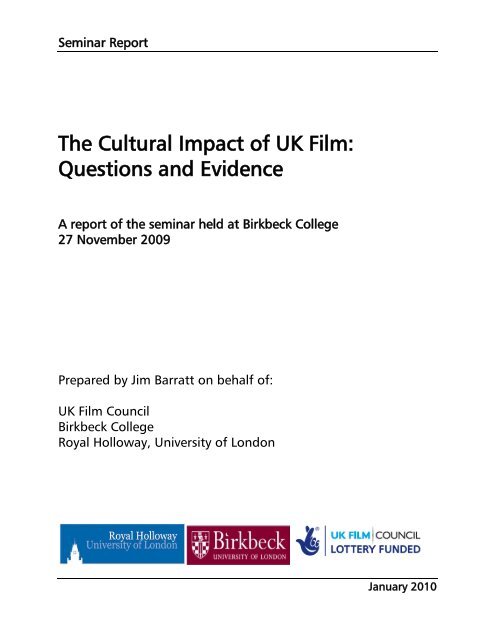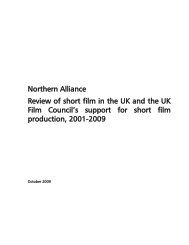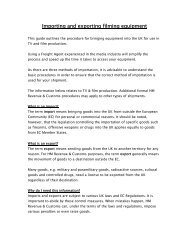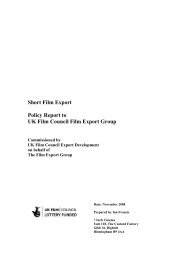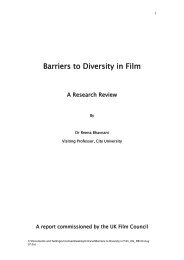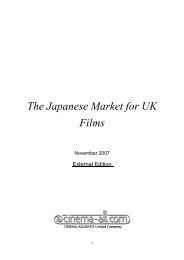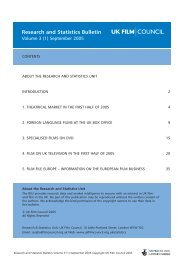The Cultural Impact of UK Film: Questions and Evidence
The Cultural Impact of UK Film: Questions and Evidence
The Cultural Impact of UK Film: Questions and Evidence
You also want an ePaper? Increase the reach of your titles
YUMPU automatically turns print PDFs into web optimized ePapers that Google loves.
Seminar Report<br />
<strong>The</strong> <strong>Cultural</strong> <strong>Impact</strong> <strong>of</strong> <strong>UK</strong> <strong>Film</strong>:<br />
<strong>Questions</strong> <strong>and</strong> <strong>Evidence</strong><br />
A report <strong>of</strong> the seminar held at Birkbeck College<br />
27 November 2009<br />
Prepared by Jim Barratt on behalf <strong>of</strong>:<br />
<strong>UK</strong> <strong>Film</strong> Council<br />
Birkbeck College<br />
Royal Holloway, University <strong>of</strong> London<br />
January 2010
Contents<br />
Introduction 3<br />
Section one:<br />
Welcome, introduction <strong>and</strong> findings 4<br />
Section two:<br />
Panel discussions 9<br />
Section three:<br />
Group discussion <strong>and</strong> report back 20<br />
Programme 24<br />
Speakers 25<br />
List <strong>of</strong> attendees 27<br />
2
Introduction<br />
In 2008 the <strong>UK</strong> <strong>Film</strong> Council commissioned a consortium <strong>of</strong> Narval Media, Birkbeck<br />
College <strong>and</strong> Media Consulting Group to undertake a study <strong>of</strong> the cultural impact <strong>of</strong> <strong>UK</strong><br />
film in the period 1946 to 2006, a project undertaken jointly with the British <strong>Film</strong><br />
Institute.<br />
<strong>The</strong> final report, Stories we tell ourselves: the cultural impact <strong>of</strong> <strong>UK</strong> film 1946-2006,<br />
was published by the <strong>UK</strong> <strong>Film</strong> Council in June 2009 1 , <strong>and</strong> in the following November<br />
the research was presented to academic, policy <strong>and</strong> commercial researchers at a<br />
seminar hosted by the <strong>UK</strong> <strong>Film</strong> Council, Birkbeck College <strong>and</strong> Royal Holloway,<br />
University <strong>of</strong> London.<br />
<strong>The</strong>se seminar notes summarise the day‘s proceedings, capturing the chief points <strong>of</strong><br />
discussion about how the <strong>UK</strong> <strong>Film</strong> Council <strong>and</strong> the wider research community can best<br />
build on the research going forward. 2<br />
<strong>The</strong> notes are divided into three sections that follow the main contours <strong>of</strong> the seminar<br />
programme (see page 24). Section one begins with the welcome address delivered by<br />
Carol Comley <strong>and</strong> David Steele‘s scene-setting introduction, before moving on to Ian<br />
Christie‘s presentation <strong>of</strong> the research team‘s methodology <strong>and</strong> principal findings.<br />
<strong>The</strong> second section reports the two panel discussions that straddled the lunch break,<br />
chaired by John Hill <strong>and</strong> Sara Selwood with contributions from Roy Boyne, Christine<br />
Geraghty, Máire Messenger Davies <strong>and</strong> Richard Howells.<br />
<strong>The</strong> final section summarises the answers delivered during a plenary report back<br />
following group discussion <strong>of</strong> three pre-prepared questions about the research.<br />
1 <strong>The</strong> main body <strong>of</strong> the report is available to download from the <strong>UK</strong> <strong>Film</strong> Council website<br />
(http://www.ukfilmcouncil.org.uk/media/pdf/f/i/CIReport_010709.pdf), along with the appendices<br />
(http://www.ukfilmcouncil.org.uk/media/pdf/n/b/<strong>Cultural</strong><strong>Impact</strong>Appendices_260609.pdf).<br />
2 Four PowerPoint presentations were delivered at the seminar, <strong>and</strong> they are available from the<br />
<strong>UK</strong> <strong>Film</strong> Council web site: http://www.ukfilmcouncil.org.uk/culturalimpactseminar09.<br />
3
Section one: Welcome, introduction <strong>and</strong> report findings<br />
‗We really want to know what you think.‘<br />
Carol Comley, Head <strong>of</strong> Strategic Development, <strong>UK</strong> <strong>Film</strong> Council<br />
Carol Comley welcomed delegates by noting the seminar was one <strong>of</strong> a series<br />
addressed to researchers <strong>and</strong> policy makers, in the <strong>UK</strong> <strong>and</strong> Europe, intended to<br />
Disseminate the research findings;<br />
Stimulate discussion <strong>of</strong> the methodology;<br />
Gather suggestions for future research initiatives.<br />
At a time when public funding for film in the <strong>UK</strong> is facing cut backs, Carol said the<br />
event provided a timely opportunity to contribute to the <strong>UK</strong> <strong>Film</strong> Council‘s strategic<br />
planning, particularly in light <strong>of</strong> the <strong>UK</strong> <strong>Film</strong> Council Board‘s proposal to increase<br />
research funding, as feedback from the event would help to inform the choice <strong>of</strong><br />
future research.<br />
‗We want to collect something from the day that‘s concrete, which we can take<br />
forward into either what we do as the <strong>UK</strong> <strong>Film</strong> Council or what you do as an<br />
academic <strong>and</strong> policy community.‘<br />
David Steele, Head <strong>of</strong> Research & Statistics, <strong>UK</strong> <strong>Film</strong> Council<br />
David Steele introduced the main programme with a look at how the research<br />
came into being, <strong>and</strong> the factors that led to its commissioning. 3<br />
Although the fieldwork <strong>and</strong> data collection were conducted in 2008, the study had<br />
a longer gestation period during which time the focus shifted from measuring the<br />
monetary value <strong>of</strong> film culture to examining cultural impact.<br />
In the period 2003 to 2005, the <strong>UK</strong> <strong>Film</strong> Council researched the economic impact <strong>of</strong><br />
<strong>UK</strong> film <strong>and</strong> considered whether a similar approach could be taken to produce a<br />
valuation <strong>of</strong> film culture.<br />
<strong>The</strong> Research <strong>and</strong> Statistics Unit looked at various methodologies, including<br />
hedonic pricing <strong>and</strong> contingent valuation, <strong>and</strong> consulted with various authorities<br />
including DCMS, the Imperial College team involved in assessing the value <strong>of</strong> the<br />
Olympics, <strong>and</strong> academic David Throsby. <strong>The</strong> <strong>UK</strong> <strong>Film</strong> Council, in collaboration with<br />
Royal Holloway, University <strong>of</strong> London hosted an event on the subject, but<br />
ultimately, ‗we weren‘t convinced enough to go down that particular road‘, due to<br />
concerns about methodological shortcomings <strong>and</strong> the expense <strong>of</strong> such approaches.<br />
At the time the research specification was being drawn up it was decided to shift<br />
focus to look at cultural impact:<br />
‗[Measuring] impact makes the study wider <strong>and</strong> potentially more interesting<br />
than just diving into a valuation exercise.‘<br />
3<br />
David’s slideshow presentation is available to download from the <strong>UK</strong> <strong>Film</strong> Council web site:<br />
http://www.ukfilmcouncil.org.uk/media/powerpoint/8/s/DS_<strong>Cultural</strong>_<strong>Impact</strong>_Background_27_<br />
Nov_09.ppt<br />
4
‗We have introduced a longer time span for thinking about British cinema […]<br />
<strong>and</strong> a wider spectrum <strong>of</strong> indicators for the assessment <strong>of</strong> British cinema‘s impact<br />
than are traditionally used.‘<br />
Ian Christie, Pr<strong>of</strong>essor <strong>of</strong> <strong>Film</strong> <strong>and</strong> Media History, Birkbeck College<br />
Ian Christie began his summary <strong>of</strong> the methodology <strong>and</strong> principal findings by<br />
explaining that the research in a sense continues the work begun by the AHRC<br />
Centre for British <strong>Film</strong> <strong>and</strong> Television Studies. 4<br />
Also by way <strong>of</strong> background, Ian noted that the idea <strong>of</strong> studying ‗impact‘ may be<br />
tarnished by association with plans by Higher Education funding bodies to replace<br />
the Research Assessment Exercise (RAE) with the Research Excellence Framework<br />
(REF), which will require university departments to demonstrate the intended<br />
impact <strong>of</strong> their academic research. 5 In view <strong>of</strong> the controversial nature <strong>of</strong> these<br />
proposals, academic researchers may be deterred from addressing the subject <strong>of</strong><br />
‗impact‘ in future research.<br />
Nonetheless, the research team is clear that studying cultural impact is worthwhile :<br />
‗We, the study team, do feel that measurable cultural impact is significant <strong>and</strong><br />
[…] can help to place film within the parameters <strong>of</strong> the contemporary world,<br />
amongst the world <strong>of</strong> clicks, <strong>of</strong> page views etc.‘<br />
Turning to the report findings, Ian expressed the team‘s hope that the study will<br />
provide a platform for future research on the relationship between films <strong>and</strong><br />
audiences, help to modernise the prevailing view <strong>of</strong> <strong>UK</strong> films <strong>and</strong> introduce a wider<br />
set <strong>of</strong> measures into the study <strong>of</strong> British film than has been employed within<br />
academic research to date.<br />
In order to conduct the research, the team had to operationalise three concepts:<br />
impact, culture <strong>and</strong> Britishness.<br />
<strong>Impact</strong><br />
<strong>The</strong> study team identified a range <strong>of</strong> impact measures across three axes, based on<br />
work originally conducted by the Public Broadcasting Service in the USA <strong>and</strong> cited<br />
by the BBC in its specification <strong>of</strong> Public Value:<br />
Original impact (e.g. initial release history, admissions, festival appearances);<br />
Extended impact (e.g. awards, DVD reissues, restoration, best lists<br />
―canonisation‖);<br />
Wider impact (e.g. citation in other media, evidence <strong>of</strong> esteem, evidence <strong>of</strong><br />
impact on behaviour <strong>and</strong> society, IMDb rating, YouTube clips).<br />
Culture<br />
In addition to operationalising ‗impact‘, the team had to define what it meant by<br />
culture <strong>and</strong> was influenced by the work <strong>of</strong> Raymond Williams, Pierre Bourdieu <strong>and</strong><br />
Clifford Geertz.<br />
4<br />
Ian’s slideshow presentations is available to download from the <strong>UK</strong> <strong>Film</strong> Council web site:<br />
http://www.ukfilmcouncil.org.uk/media/powerpoint/7/d/CI_Report_Presentation_Ian_Christie_<br />
27_Nov.ppt<br />
5<br />
See HEFCE’s web site for details <strong>of</strong> the REF: http://www.hefce.ac.uk/Research/ref/.<br />
MeCCSA, the subject association for the field <strong>of</strong> media, communication <strong>and</strong> cultural studies,<br />
submitted a response to HEFCE’s REF consultation:<br />
http://www.meccsa.org.uk/papers/responses/response-to-hefce-consultation-on-the-ref<br />
5
Geertz‘s concept <strong>of</strong> culture as ‗stories we tell ourselves about ourselves‘ became<br />
central to the research:<br />
‗We needed an approach to culture that didn‘t immediately run aground on<br />
the issues <strong>of</strong> class <strong>and</strong> education, which are so central in Bourdieu […] <strong>The</strong> best<br />
solution seemed to be to turn to anthropology, so we borrowed Clifford<br />
Geertz‘s more dynamic concept <strong>of</strong> the ensemble <strong>of</strong> stories that societies tell<br />
each other, from his book <strong>The</strong> Interpretation <strong>of</strong> Cultures.‘<br />
Britishness<br />
<strong>The</strong> final definitional point to decide was what constitutes a British film. This was<br />
challenging, not least because much <strong>of</strong> British cinema is ‗the unknown cinema‘, to<br />
use Alan Lovell‘s description. 6 <strong>The</strong> level <strong>of</strong> knowledge about British cinema remains<br />
‗patchy <strong>and</strong> thin‘: the national filmography is incomplete, knowledge <strong>of</strong> individual<br />
films <strong>and</strong> their box <strong>of</strong>fice performance is inconsistent <strong>and</strong> many historical titles<br />
remain inaccessible to contemporary audiences.<br />
In consequence, ‗we have a problem in depth <strong>and</strong> extent <strong>of</strong> our knowledge <strong>of</strong><br />
British Cinema.‘<br />
To address this, the team compiled a searchable database <strong>of</strong> around 5,000 British<br />
fiction films made between 1946 <strong>and</strong> 2006 (post World War II), using available<br />
sources including Denis Gifford‘s <strong>The</strong> British <strong>Film</strong> Catalogue (the post-war period<br />
was chosen because the information is more complete).<br />
‗We have produced the skeleton <strong>of</strong> a resource, which I think will be <strong>of</strong> value in<br />
future, <strong>and</strong> I very much hope […] it will be carried forward.‘<br />
An added complication is that the concept <strong>of</strong> British national identity is itself open<br />
to debate:<br />
‗British cinema is a notoriously slippery category […] <strong>and</strong> this slipperiness<br />
actually mirrors the problem <strong>of</strong> British identity itself […] It is clear that<br />
Britishness is an essentially contested or unstable concept.‘<br />
In the face <strong>of</strong> these challenges, <strong>and</strong> due to time limitations, the team took a<br />
pragmatic decision about what constitutes a British film.<br />
Inspired by Bordwell, Staiger <strong>and</strong> Thompson‘s approach to the study <strong>of</strong> classical<br />
Hollywood cinema 7 , the team drew two samples from the film database <strong>and</strong><br />
analysed them using a range <strong>of</strong> variables <strong>of</strong> interest within public policy discussions<br />
about ‗British values‘.<br />
<strong>The</strong> two samples comprised a r<strong>and</strong>om sample <strong>of</strong> 200 films drawn from the<br />
database <strong>and</strong> an intuitive selection <strong>of</strong> 200 films felt to be significant <strong>and</strong> <strong>of</strong> lasting<br />
value by pr<strong>of</strong>essional observers.<br />
<strong>The</strong> team also ran a ‗closer analysis‘ <strong>of</strong> 30 culturally significant case study films<br />
using the three dimensions <strong>of</strong> impact described above, to see ‗how these three<br />
types <strong>of</strong> impact might play out.‘<br />
6 Lovell, A, <strong>The</strong> British Cinema: the Unknown Cinema, BFI, 1969.<br />
7 Bordwell, D; Staiger, J <strong>and</strong> Thompson, K; 1985: <strong>The</strong> Classical Hollywood Cinema: <strong>Film</strong><br />
Style <strong>and</strong> Mode <strong>of</strong> Production to 1960, London, Routledge & Kegan Paul.<br />
6
Ian said that although the findings <strong>of</strong> this close analysis may not reveal any<br />
particularly new insights, they do serve to illustrate how the life <strong>of</strong> films, <strong>and</strong><br />
therefore the scope <strong>of</strong> their potential impact, has been extended in recent years,<br />
‗which very much relates to the digital era‘:<br />
‗It is important to point out that the once quite short lifespan <strong>of</strong> most films has<br />
been extended quite extraordinarily […] <strong>The</strong> extent to which we‘re still<br />
surrounded by films from the last 50 or 70 years is a very material fact <strong>and</strong> will<br />
undoubtedly change attitudes towards the history <strong>of</strong> British cinema.‘<br />
Ian also explained that ‗wider impact‘ was examined from the perspectives <strong>of</strong>:<br />
Instances <strong>of</strong> censorship <strong>and</strong> notoriety;<br />
Quotations in other media;<br />
Zeitgeist moments.<br />
In addition to charting <strong>UK</strong> films‘ original, extended <strong>and</strong> wider impact, the report<br />
has chapters on the effects <strong>of</strong> <strong>UK</strong> films on national <strong>and</strong> regional identity, on our<br />
underst<strong>and</strong>ing <strong>of</strong> ethnic identity <strong>and</strong> diversity, <strong>and</strong> on international audiences‘<br />
perceptions <strong>of</strong> the <strong>UK</strong>.<br />
In this latter regard, the study points to a difference between how international<br />
audiences perceive British films made on a low budget <strong>and</strong> the big budget inward<br />
investment features, like the Harry Potter franchise, which are judged in the same<br />
terms as other US studio releases:<br />
‗We found there is a disjunction between what is recognised a clearly British,<br />
which is quite a narrow conception <strong>of</strong> Britishness <strong>and</strong> tends to be low budget,<br />
authorial film in one <strong>of</strong> the recognised British genres; <strong>and</strong> the big budget<br />
inward investment productions which are technically British <strong>and</strong> may have<br />
many British components, but once dubbed <strong>and</strong> marketed by a studio are<br />
widely perceived as studio pictures <strong>and</strong> not really British at all.‘<br />
Ian described how the study ends with a look at the role <strong>of</strong> film policy, <strong>and</strong> <strong>of</strong><br />
‗changing government attitudes to the British film industry.‘ <strong>The</strong> research team<br />
hopes the report will make clear to readers who may be unaware <strong>of</strong> earlier periods<br />
<strong>of</strong> public policy that market interventions have enabled <strong>and</strong> sustained the British<br />
film industry since the 1920s.<br />
In terms <strong>of</strong> omissions, the research team is aware the study does not take account<br />
<strong>of</strong> audience perspectives, <strong>and</strong> Ian suggested this is an avenue the <strong>UK</strong> <strong>Film</strong> Council<br />
could pursue in future:<br />
‗<strong>The</strong>re are generational <strong>and</strong> ideological issues that are crying out to be<br />
explored by [empirical audience research]: let‘s hope the <strong>UK</strong> <strong>Film</strong> Council is<br />
minded to fund such research in the future.‘<br />
Ian closed by <strong>of</strong>fering three other items on his future research wishlist:<br />
A comprehensive national filmography;<br />
Further research to explore empirically film cycles with ‗complex meanings‘<br />
(e.g. Ealing comedies <strong>and</strong> other ‗clusters‘), asking audiences about what<br />
these films mean to them, <strong>and</strong> taking a similar approach to the work <strong>of</strong><br />
John Sedgwick <strong>and</strong> Martin Barker et al; 8<br />
8 Sedgwick, J (2000): Popular <strong>Film</strong>going in 1930s Britain: A Choice <strong>of</strong> Pleasures, Exeter,<br />
University <strong>of</strong> Exeter Press.<br />
7
Study new film viewing patterns <strong>and</strong> how these are affecting spectatorship<br />
in the digital age.<br />
<strong>Questions</strong> <strong>and</strong> answers<br />
Sylvia Harvey (Pr<strong>of</strong>essor <strong>of</strong> Broadcasting Policy, University <strong>of</strong> Lincoln) suggested it<br />
might be useful to ‗follow the money‘, <strong>and</strong> distinguish between knowledge that<br />
comes from academic research <strong>and</strong> that which issues from a public policy context.<br />
‗Different sorts <strong>of</strong> knowledge are motivated by different sources <strong>of</strong> funding‘. This<br />
piece <strong>of</strong> research straddles both, which makes it interesting.<br />
Samm Haillay (Producer Better Things, part-time lecturer Teesside University) asked<br />
whether research should measure the impact <strong>of</strong> <strong>UK</strong> cultural film rather than<br />
concentrate on measuring the cultural impact <strong>of</strong> <strong>UK</strong> film.<br />
In reply, Ian Christie stated that a number <strong>of</strong> cultural films appear in the research,<br />
but that the team sought to balance cultural <strong>and</strong> mainstream films in the samples<br />
because the distinction has been inhibiting in previous research. What constitutes a<br />
cultural film is open to debate <strong>and</strong> may change over time.<br />
David Graham (Attentional) said he was interested in the difference between the<br />
more subversive attitude <strong>of</strong> the intuitive sample <strong>of</strong> <strong>UK</strong> films <strong>and</strong> the more<br />
affirmative values <strong>of</strong> the r<strong>and</strong>om sample. He wondered whether this reflects<br />
different audiences for these films: one which is more open to change <strong>and</strong> the<br />
other which wants to be entertained <strong>and</strong> its values affirmed.<br />
Responding, Ian Christie agreed it was tempting to read the evidence in this way.<br />
<strong>The</strong> intuitive sample may have been valued precisely because the films are more<br />
challenging <strong>and</strong> provocative. But Ian noted that most <strong>of</strong> the films from both<br />
samples are seen by a wide range <strong>of</strong> people who may value them in different ways.<br />
<strong>The</strong> quantitative analyses have thrown up some broad features <strong>of</strong> British cinema,<br />
which may be useful for forming hypotheses, but the reality is more complex <strong>and</strong><br />
requires more sophisticated methods.<br />
Barker, M; Arthurs, J <strong>and</strong> Harindranath, R; (2001): <strong>The</strong> Crash Controversy: Censorship<br />
Campaigns <strong>and</strong> <strong>Film</strong> Reception, London, Wallflower Press.<br />
8
Section two: Panel discussions<br />
Morning panel<br />
‗It seems to me that this move towards the analysis <strong>of</strong> cultural impact is a<br />
valuable one to which we as an academic community can contribute.‘<br />
John Hill, Pr<strong>of</strong>essor <strong>of</strong> Media, Royal Holloway, University <strong>of</strong> London<br />
John Hill, Chair <strong>of</strong> the morning panel, explained in his introduction why he<br />
welcomed the opportunity to discuss the research with representatives <strong>of</strong> the wider<br />
academic research community. Noting that the <strong>UK</strong> <strong>Film</strong> Council has tended in the<br />
past to seek academic input from outside film <strong>and</strong> cultural studies, John indicated<br />
his wish to encourage ‗a rapprochement‘ between film/cultural studies <strong>and</strong> film<br />
policy makers.<br />
Previous policy-related research, John suggested, had tended to focus on the<br />
economic or social impact <strong>of</strong> film, so the move towards studying cultural impact<br />
brought such research closer to the traditional concerns <strong>of</strong> film <strong>and</strong> cultural<br />
studies..<br />
Picking up on Sylvia Harvey‘s point in the earlier Q&A, John agreed there are two<br />
discourses informing thinking around cultural impact:<br />
On the one h<strong>and</strong>, the <strong>UK</strong> <strong>Film</strong> Council champions the <strong>UK</strong> film industry to<br />
secure ongoing public support, <strong>and</strong> it relies on appropriate evidence to<br />
make its case;<br />
In academia, examining the influence <strong>of</strong> British films (e.g. in relation to the<br />
construction <strong>of</strong> ethnic <strong>and</strong> national identities) is long established even if film<br />
scholars have not previously used the term ‗cultural impact‘.<br />
John summed up his introduction by reiterating the seminar‘s aims:<br />
To help the <strong>UK</strong> <strong>Film</strong> Council devise future research questions <strong>and</strong><br />
methodologies;<br />
To encourage colleagues to embrace the cultural impact agenda without<br />
being confined to any particular line <strong>of</strong> enquiry or approach, ‗to be active<br />
participants in thinking about the cultural impact <strong>of</strong> <strong>UK</strong> film <strong>and</strong> how it<br />
might be identified <strong>and</strong> studied.‘<br />
‗I set myself the task <strong>of</strong> asking whether or not thinking about cultural impact<br />
<strong>and</strong> <strong>UK</strong> film is what the business school <strong>and</strong> policy people might call a ‗wicked<br />
problem‘ […] It did seem to me that what was being done in the <strong>UK</strong> <strong>Film</strong><br />
Council report wasn‘t a classic wicked problem, but it did link to a wicked<br />
problem. I thought that what the report was saying […] was that <strong>UK</strong> film has in<br />
fact had a significant impact on large numbers <strong>of</strong> people. It has helped<br />
substantially to change cultural mindsets <strong>of</strong> various kinds. And this institutional<br />
performance has been significant.‘<br />
Roy Boyne, Pr<strong>of</strong>essor in the School <strong>of</strong> Applied Social Sciences, Durham<br />
University.<br />
9
<strong>The</strong> first speaker, Roy Boyne, began by describing the study <strong>of</strong> cultural impact as<br />
akin to a ‗wicked problem‘. 9<br />
A wicked problem is one ‗whose solutions require large groups <strong>of</strong> individuals to<br />
change their mindsets <strong>and</strong> behaviours‘. Wicked problems share a number <strong>of</strong><br />
characteristics, including the lack <strong>of</strong> any definitive formulation <strong>of</strong> the problem.<br />
Importantly, solutions to wicked problems are not true or false but they can be<br />
good or bad, <strong>and</strong> there are no proper tests <strong>of</strong> the adequacy <strong>of</strong> solutions. On a<br />
positive note, although they may be unsolvable, ‗thinking about wicked problems<br />
may make connections where previously none existed.‘<br />
Roy then elaborated a series <strong>of</strong> questions <strong>and</strong> thoughts that struck him on reading<br />
the study:<br />
Were the impacts described in the report unintended? <strong>The</strong> answer to this is<br />
‗really rather complex‘.<br />
Is <strong>UK</strong> film an agency in <strong>and</strong> <strong>of</strong> itself? ‗Can one talk intelligently about <strong>UK</strong><br />
film <strong>and</strong> its impacts? Does that discourse create <strong>UK</strong> film as an agency?‘.<br />
Measuring change over time is crucial, <strong>and</strong> similarities <strong>and</strong> differences<br />
between generations need to be taken into account: ‗<strong>The</strong> issue <strong>of</strong><br />
generations is supremely important when thinking about cultural impact in<br />
a directed <strong>and</strong> concerned-for-the-future sort <strong>of</strong> way.‘<br />
Is the report intended to make an advocacy case for public support for film?<br />
Is the report ‗the beginning <strong>of</strong> something, or the end <strong>of</strong> something?‘ A<br />
central message <strong>of</strong> the report is that <strong>UK</strong> film has made a significant<br />
contribution to <strong>UK</strong> culture (what Roy termed ‗institutional performance‘). In<br />
this regard the report is a ‗political intervention‘ that makes ‗a significant<br />
contribution‘ to the advocacy case.<br />
However, there is no test <strong>of</strong> the evidence to support this case. <strong>The</strong> report,<br />
instead, provides evidence <strong>of</strong> outcomes <strong>and</strong> ‗markers <strong>of</strong> cultural change‘.<br />
As such the report does not satisfy the test <strong>of</strong> ‗regularity‘ (e.g. ‗that every<br />
time you do this set <strong>of</strong> things, the same thing will follow‘), which is one<br />
criterion <strong>of</strong> ‗causal adequacy‘. It does, however, satisfy the other criterion <strong>of</strong><br />
‗adjacency‘ or ‗succession‘. <strong>The</strong> report implies that if you do more <strong>of</strong> the<br />
same in future, the same beneficial change will follow. But the report makes<br />
very few references to negative impacts. ‗<strong>The</strong>re was no sustained<br />
consideration <strong>of</strong> impacts other than those that were positive.‘<br />
Turning to the wider context <strong>of</strong> impact assessment in the arts <strong>and</strong> cultural sector,<br />
Roy shared a list <strong>of</strong> outcomes <strong>of</strong> cultural interventions that were popular in 1997<br />
when New Labour came to power (including items such as ‗increase in individual<br />
employability‘, ‗reduction in youth crime <strong>and</strong> alienation‘, ‗recognition <strong>of</strong><br />
environmental responsibilities‘ etc.). It is now widely accepted that cultural<br />
investment cannot always guarantee these instrumental outcomes in any<br />
predictable, dependable way.<br />
Looking to possible approaches to research going forward, Roy recommended that,<br />
if impact-led research becomes necessary, it might begin by:<br />
Formulating, debating <strong>and</strong> testing impact hypotheses regarding output over<br />
a limited past period <strong>of</strong> between three <strong>and</strong> five years;<br />
9<br />
Roy’s slideshow presentation is available to download from the <strong>UK</strong> <strong>Film</strong> Council web site:<br />
http://www.ukfilmcouncil.org.uk/media/powerpoint/6/n/Roy_Boyne_CI_Presentation_Nov09_fi<br />
nal.ppt<br />
10
<strong>The</strong>reafter modelling future impact over a period <strong>of</strong>, say, three years, not so<br />
much to test a particular model, but more to see the impact <strong>of</strong> its existence<br />
over the period.<br />
As more public agencies, he advised, are required to ‗make a contract with the<br />
world to do something within a specific time frame,‘ a level <strong>of</strong> preparation might<br />
become invaluable.<br />
‗‗I‘m really encouraged to see that the <strong>UK</strong> <strong>Film</strong> Council, at the end <strong>of</strong> the report,<br />
does call for change <strong>and</strong> possibilities within the mainstream educational system,<br />
<strong>and</strong> I‘m sure we would be pleased to work with that. But an acknowledgment <strong>of</strong><br />
education <strong>and</strong> its impact as a thread through the report would be a very good<br />
place to start.‘<br />
Christine Geraghty, Pr<strong>of</strong>essor <strong>of</strong> <strong>Film</strong> & Television Studies, University <strong>of</strong> Glasgow.<br />
Christine Geraghty began her presentation by welcoming the report for broadening<br />
the measures <strong>of</strong> <strong>UK</strong> film impact beyond ‗box <strong>of</strong>fice figures <strong>and</strong> economic<br />
measures‘.<br />
In thinking about the purpose served by the study, Christine assumed the report<br />
exists for people who need to be convinced <strong>of</strong> the case for supporting <strong>UK</strong> film with<br />
public money. She also noted that it ‗involves a particular rhetoric <strong>and</strong> a particular<br />
paradigm, […] around the creative industries or cultural policy‘. In this context<br />
Christine questioned whether the wording in the Foreword was strictly true- ‗do we<br />
really all feel good about <strong>UK</strong> film success?‘, <strong>and</strong> she is interested in to whom the<br />
‗we‘ in the Foreword refers.<br />
Turning to main body <strong>of</strong> the report, Christine commented on three aspects <strong>of</strong> the<br />
methodology:<br />
She questioned the assumption that impact can ever be ‗a single item‘:<br />
‗It is important to note that impact, <strong>of</strong> course, can never be a single item. It<br />
is unrealistic <strong>and</strong> wrong to assume that a single film can have an impact<br />
that can be directly related to it. And sometimes that did seem to happen in<br />
the report, with Bend it Like Beckham being responsible for the<br />
development <strong>of</strong> women‘s football in India.‘<br />
Social change results instead from a confluence <strong>of</strong> factors within a specific<br />
context, <strong>and</strong> this should be reflected in any impact study.<br />
<strong>The</strong> passage <strong>of</strong> time is a crucial factor when measuring cultural impact,<br />
especially with reference to the report‘s concepts <strong>of</strong> zeitgeist moments <strong>and</strong><br />
cumulative impact, <strong>and</strong> this temporal aspect could be further developed.<br />
For example, there is a real difference in the content <strong>and</strong> aesthetics <strong>of</strong> films<br />
made in 1946 <strong>and</strong> 2006.<br />
<strong>The</strong> impact <strong>of</strong> individual films can also vary over time, <strong>and</strong> there are ‗peaks<br />
<strong>of</strong> attention‘ within a film‘s lifetime from the moment <strong>of</strong> release to its<br />
extended life on other platforms, through remakes, sequels etc.<br />
Television‘s role in positioning British cinema <strong>and</strong> making it accessible has<br />
also changed over this period, <strong>and</strong> ‗would repay further study‘. In the past,<br />
for example, TV scheduling played a part in popularising certain films <strong>and</strong><br />
cycles (e.g. Ealing comedies).<br />
11
<strong>The</strong> use <strong>of</strong> a variety <strong>of</strong> indicators <strong>of</strong> wider impact is ‗very interesting‘, but<br />
‗different impact measures relate to different audiences‘ e.g. regular users<br />
<strong>of</strong> IMDb are different to other audience groups. Use <strong>of</strong> such measures<br />
therefore ‗needs to be treated with some subtlety‘.<br />
Christine then outlined three broader points about the report:<br />
‗<strong>The</strong> report is organised around the national, […] however that‘s defined‘,<br />
but this may be ‗over-determined‘ because the study was commissioned<br />
within a public policy context where such a paradigm is relevant. In<br />
deference to this paradigm, the report is ‗politically safe‘ by being inclusive.<br />
Christine linked this point to a remark made in Ian Christie‘s presentation<br />
that studies <strong>of</strong> impact ‗focus on what is obvious‘; this is because a great<br />
deal <strong>of</strong> work has already been done on British cinema <strong>and</strong> national identity.<br />
Christine went on to argue there is an over-emphasis on certain types <strong>of</strong><br />
films from the nations/regions <strong>and</strong> involving the representation <strong>of</strong> ethnic<br />
minorities.<br />
In terms <strong>of</strong> the nations <strong>and</strong> regions, the report deploys ‗unsafe terminology‘<br />
around Britishness. For example, Gordon Brown‘s definition <strong>of</strong> British<br />
values, quoted in the report, may be read as a version <strong>of</strong> Englishness.<br />
Christine acknowledged the section on ethnicity does <strong>of</strong>fer a useful<br />
summary, but this is an area where impact goes beyond British films (<strong>and</strong><br />
beyond Channel 4‘s support for British film). <strong>The</strong> impact on ethnic identity is<br />
related to much wider debates <strong>and</strong> social changes that were occurring at<br />
the time these films were released.<br />
In response to these challenges, Christine wondered whether the database<br />
could be analysed in another way to avoid such difficulties <strong>and</strong> still make<br />
the case for cultural impact. For example, an alternative analysis could<br />
proceed from the list <strong>of</strong> themes <strong>and</strong> variations that are characteristic <strong>of</strong><br />
British films, to explore them in greater depth (page 18 <strong>of</strong> the report): ‗It<br />
might have been useful to use that map more.‘<br />
Gender is largely neglected, in contrast to the report‘s preoccupation with<br />
national, regional <strong>and</strong> ethnic identity. <strong>The</strong> list <strong>of</strong> 30 case study titles (on<br />
page 25) is ‗very male oriented‘, <strong>and</strong> alternatives reflecting more female<br />
preoccupations could have been included (e.g. <strong>The</strong> Red Shoes):<br />
‗If the examples on the list had been different it would have worked<br />
differently, I think. Ideas about the position <strong>of</strong> women have changed<br />
dramatically since the Second World War, at least as much as national<br />
identity. Did cinema reflect on that? Did it have an impact on that? Or did it<br />
actually impede that?‘.<br />
<strong>The</strong> report downplays aesthetic changes in British films over the period:<br />
‗<strong>The</strong> report does refer to particular aesthetic features, but what would<br />
happen if further work looked at impact as it played through some aesthetic<br />
criteria?‘<br />
12
Q&A<br />
For example, the impact <strong>of</strong> social realism may play differently in different<br />
periods.<br />
It may also be helpful to examine ‗the fantastic <strong>and</strong> the melodramatic‘ in<br />
British film, to shed new light on the relationship between <strong>UK</strong> <strong>and</strong> US<br />
filmmaking traditions. In another suggestion, Christine noted that<br />
performance is recognised in the report only in terms <strong>of</strong> awards, but<br />
performance may have impact in other ways. ‗What would happen if the<br />
[30] films listed were reworked to use performance as a key indicator, or at<br />
least as an organising principle?‘<br />
<strong>The</strong> ‗production circumstances‘ <strong>of</strong> films are also neglected in the report, <strong>and</strong><br />
should carry equal weight alongside the section on public policy e.g. links<br />
with visual arts, television industry etc.<br />
‗I just think there are different ways <strong>of</strong> cutting what is actually an<br />
enormously exciting resource if it‘s made available.‘<br />
Christine‘s third general point is not exclusive to this report, but reflected on<br />
an attitude ‗typical <strong>of</strong> how public funders pay attention to education‘.<br />
Despite calling for greater involvement <strong>of</strong> media education in the national<br />
curriculum (a call supported by Christine), the report fails to do justice to<br />
the role <strong>of</strong> education in promoting knowledge <strong>and</strong> underst<strong>and</strong>ing <strong>of</strong> British<br />
film, <strong>and</strong> teachers are not acknowledged as gatekeepers or enablers in this<br />
regard, nor their impact on ‗generations <strong>of</strong> learners‘:<br />
‗I think there is a lack <strong>of</strong> attention paid to education <strong>and</strong> the role <strong>of</strong><br />
educators in how British cinema makes an impact.‘<br />
Steve Chibnall (Pr<strong>of</strong>essor <strong>of</strong> British Cinema, De Montfort University) picked up on<br />
the issue <strong>of</strong> ‗negative impact‘ <strong>and</strong> links to national <strong>and</strong> regional identity. He gave<br />
the example <strong>of</strong> Get Carter <strong>and</strong> observed that film can become a focus <strong>of</strong> resistance<br />
to the zeitgeist, <strong>and</strong> as such ‗impact‘ could be deeply reactionary.<br />
Christine Geraghty agreed that resistance is not always progressive, <strong>and</strong> many films<br />
<strong>of</strong> the 1950s <strong>of</strong>fered ‗a space <strong>of</strong> resistance‘ to modernisation in the wider society.<br />
Alan Lovell (independent researcher) questioned the specification <strong>of</strong> British values<br />
favoured by the present government:<br />
‗I‘m doubtful <strong>of</strong> the value <strong>of</strong> discussing British cinema in relation to questions<br />
<strong>of</strong> social identity <strong>and</strong> national identity, social attitudes <strong>and</strong> values. It seems to<br />
me to be part <strong>of</strong> a long tradition <strong>of</strong> a rather utilitarian approach to cinema in<br />
British culture. But if we are going to discuss it in those terms, can we agree<br />
that Gordon Brown‘s <strong>and</strong> Margaret Hodge‘s definitions are unsatisfactory in<br />
that they could apply to a number <strong>of</strong> societies, not only Britain.‘<br />
Mark Reid (Head <strong>of</strong> Education, British <strong>Film</strong> Institute) supported Christine Geraghty‘s<br />
call for a greater emphasis on media education. He is particularly interested in<br />
measuring cultural impact within education settings. Mark also noted the report<br />
emphasises instrumental value, with less attention paid to the intrinsic value <strong>of</strong><br />
‗children experiencing a wide range <strong>of</strong> films‘. He would like to see the development<br />
<strong>of</strong> metrics covering initiatives like FILM CLUB screenings to see if they are changing<br />
13
children‘s viewing preferences. Other initiatives, like ScreenOnline <strong>and</strong> BFI<br />
Education DVDs <strong>and</strong> classroom resources, may also have impact on children‘s<br />
knowledge <strong>and</strong> underst<strong>and</strong>ing <strong>of</strong> British film but it is going unmeasured.<br />
Charlotte Brunsdon (Pr<strong>of</strong>essor <strong>of</strong> <strong>Film</strong>, Warwick University) welcomed the <strong>UK</strong> <strong>Film</strong><br />
Council‘s involvement in cultural research, but echoed Ian Christie‘s point that<br />
‗impact has become an extremely loaded, [...] difficult <strong>and</strong> [is] about to become a<br />
truly repellent word for many people within the education system‘ as a result <strong>of</strong> the<br />
REF proposals.<br />
Charlotte cautioned against seeing impact only in terms <strong>of</strong> change: ‗Things can<br />
have impact <strong>and</strong> keep things carrying on <strong>and</strong> being the same.‘<br />
She also advised the <strong>UK</strong> <strong>Film</strong> Council not to forget the ‗huge body‘ <strong>of</strong> research that<br />
exists in relation to television, especially audience research looking at different<br />
generations. Charlotte would like to see additional longitudinal <strong>and</strong> ‗horizontal‘<br />
(‗cross-media‘) research that looks at the complexity <strong>of</strong> media usage <strong>and</strong><br />
consumption in people‘s lives.<br />
Sarah Street (Pr<strong>of</strong>essor <strong>of</strong> <strong>Film</strong>, Bristol University) picked up on Roy Boyne‘s point<br />
about the role <strong>of</strong> research in cultural investment <strong>and</strong> the next steps to follow the<br />
study. She asked, ‗what is the potential for somehow doing something with British<br />
film? […] This is historically a very tricky question […] What might a cinema so<br />
enabled look like?‘<br />
Welcoming the study, Robin MacPherson (Pr<strong>of</strong>essor <strong>of</strong> Screen Media, Edinburgh<br />
Napier University) declared his interest in the public policy uses <strong>of</strong> the research, <strong>and</strong><br />
how best to demonstrate social <strong>and</strong> cultural value to balance against economic<br />
impact:<br />
‗<strong>The</strong> policy implications <strong>of</strong> measuring cultural impact are […] politically<br />
pressing because the hidden question behind looking at the impact <strong>of</strong> film is<br />
measuring the impact <strong>of</strong> film policy […] because [public funding interventions]<br />
are going to come under scrutiny […] And one <strong>of</strong> the methodological<br />
questions that has yet been to be addressed is looking to tease out whether or<br />
not film policy interventions have the consequences which they intend. […] <strong>The</strong><br />
challenge is that if we don‘t have an adequate sense <strong>of</strong> what the cultural<br />
impacts are, <strong>of</strong> film <strong>and</strong> future film policy, we‘re left with the creative<br />
industries policy framework <strong>and</strong> only economic impact will be measured <strong>and</strong><br />
used to justify policy. So there is a positive imperative to have measures <strong>of</strong><br />
social <strong>and</strong> cultural value that have some empirical underpinning in order to<br />
make the kinds <strong>of</strong> policy argument [..] that would be required to justify policy<br />
interventions that have cultural as opposed to economic objectives. So I<br />
welcome this report- we need to be ahead <strong>of</strong> the game.‘<br />
David Graham returned to Christine Geraghty‘s point about Britishness in the<br />
report. He agreed that Britishness is ‗over defined‘ <strong>and</strong> needs to include a European<br />
element:<br />
‗We are, after all, European now, <strong>and</strong> a large part <strong>of</strong> our film economy is<br />
determined by European legislation, a large part <strong>of</strong> our film output are coproductions.<br />
[...] I get the feeling this definition is a bit retrograde <strong>and</strong> we<br />
need to be a bit more nuanced in the way we define our nationality.‘<br />
Richard Miller (Available Light Advisory) welcomed the study‘s historical view, but<br />
suggested that a more strategic perspective would also have been useful. For<br />
14
example, the insights in Table 5.1 (<strong>Impact</strong> measures <strong>and</strong> ratings for the case study<br />
films, p.25) are ‗crying out to be taken forward in a strategic way‘.<br />
In addition to cultural impact, Richard recommended looking at the impact <strong>of</strong> <strong>UK</strong><br />
film on other areas <strong>of</strong> public policy like health, education, community development<br />
etc. which might leverage additional money to support film: ‗I‘d be interested to<br />
see a study that asks what are the impacts that will open larger pocketbooks <strong>and</strong><br />
help to create more funding for film in difficult times.‘<br />
He also noted that the impact <strong>of</strong> <strong>UK</strong> film is a subset <strong>of</strong> the impact <strong>of</strong> film in<br />
general, <strong>and</strong> wondered whether it is worth seeing if work has been done elsewhere<br />
examining the impact <strong>of</strong> other national cinemas in their home countries, e.g. in<br />
Canada <strong>and</strong> Australia, by way <strong>of</strong> comparison with the <strong>UK</strong>.<br />
Sylvia Harvey reminded delegates there have been a number <strong>of</strong> different Secretaries<br />
<strong>of</strong> State for Culture since 2000 <strong>and</strong> there is a tendency for policy emphases to<br />
reflect the views <strong>of</strong> the current post-holder. If a Conservative Government is elected<br />
in 2010, ‗the big irony is [...]that the heritage/cultural case may be a stronger card<br />
to play in defending public intervention in film than the economic case.‘<br />
Holly Aylett (London Metropolitan University) also welcomed the study but was<br />
‗uneasy‘ about the notion <strong>of</strong> ‗frontiers‘ <strong>and</strong> Britishness it puts forward, because<br />
‗Britain has hugely porous walls‘. She would like to see this research as only one<br />
part <strong>of</strong> the ‗story <strong>of</strong> cultural impact <strong>and</strong> value <strong>of</strong> <strong>UK</strong> film‘, <strong>and</strong> would favour a more<br />
concerted study <strong>of</strong> the role played by distribution in the cultural impact <strong>of</strong> <strong>UK</strong> films.<br />
Afternoon panel<br />
‗<strong>The</strong> politics <strong>of</strong> cultural impact are really crucial because ultimately it‘s got to be<br />
about advocacy. However, I do think that the report, <strong>and</strong> the discussion this<br />
morning, opens up a whole debate about how it might be possible to use<br />
evidence <strong>of</strong> cultural impact in a way that the <strong>UK</strong> <strong>Film</strong> Council, the British <strong>Film</strong><br />
Institute <strong>and</strong> the sector more generally can do more than contribute to a better<br />
financial settlement in the future. So one <strong>of</strong> the questions I would ask […] is: if<br />
you can find out what [cultural impact] is, what are you going to do about it?‘<br />
Sara Selwood, Editor, <strong>Cultural</strong> Trends.<br />
Sara Selwood, Chair <strong>of</strong> the second panel discussion, began by setting out some<br />
background to the study <strong>of</strong> cultural impact in the <strong>UK</strong> with a look at DCMS‘s<br />
changing approach since 1997, when DCMS inherited a ‗failure to measure the<br />
effects <strong>of</strong> culture in any way, shape or form‘.<br />
This was remedied in 2003 with the development <strong>of</strong> the logic <strong>of</strong> ‗cultural value‘<br />
(championed by Demos, in a series <strong>of</strong> papers), <strong>and</strong> in 2004 Tessa Jowell, Secretary<br />
<strong>of</strong> State, published a paper that helped to challenge the measurement <strong>of</strong><br />
instrumental outcomes.<br />
Other recent developments include Sir Brian McMaster‘s review <strong>of</strong> excellence in the<br />
arts for DCMS, which favours decision-making based on judgement over<br />
measurement <strong>and</strong> led to thinking about peer review methodology (which may be<br />
too expensive to implement in every circumstance). 10<br />
10 See DCMS web site for details:<br />
http://www.culture.gov.uk/reference_library/publications/3577.aspx<br />
15
Sara suggested the study should be read within the context <strong>of</strong> the ‗politics <strong>of</strong><br />
cultural impact‘. She noted that demonstrating cultural impact is essentially about<br />
advocacy, but the report may nonetheless have other uses.<br />
‗Why didn‘t you just go <strong>and</strong> ask the people? […] My instinct is just to go out<br />
with a big pile <strong>of</strong> questionnaires […] <strong>and</strong> ask some people what they think many<br />
<strong>of</strong> these things are: what the impact <strong>of</strong> particular films are, what the zeitgeist<br />
moment from their childhood was? So, where is the audience in all <strong>of</strong> this?‘<br />
Máire Messenger Davies, Pr<strong>of</strong>essor <strong>of</strong> Media Studies <strong>and</strong> Director <strong>of</strong> the Media<br />
Studies Research Institute, University <strong>of</strong> Ulster.<br />
<strong>The</strong> afternoon panel‘s first speaker, Máire Messenger Davies, set out to discuss the<br />
‗how‘ <strong>of</strong> measuring cultural impact, with particular reference to researching<br />
audiences. 11<br />
‗<strong>The</strong> ‗how‘ is always a really, really big question […] It‘s a problematic issue<br />
when it comes to conducting research.‘<br />
Máire addressed four main issues in her review <strong>of</strong> the study‘s approach:<br />
‗Some general points about methodology‘<br />
Máire raised the question <strong>of</strong> research validity, <strong>and</strong> asked how representative<br />
the r<strong>and</strong>om sample <strong>of</strong> 200 films is.<br />
She also questioned use <strong>of</strong> an ‗intuitive sample‘ based on pr<strong>of</strong>essional<br />
judgement, as intuition is an amorphous concept. Furthermore, Máire<br />
detected a contradiction in use <strong>of</strong> the term ‗intuition‘, which is better<br />
applied to the judgements <strong>of</strong> those without specialist knowledge.<br />
Citing David Deacon‘s article ‗Why Counting Counts‘, in which the author<br />
challenges the use <strong>of</strong> quantitative terms in cultural studies research<br />
papers, 12 Máire identified other problems in the report‘s terminology. Words<br />
like ‗generally‘, ‗lasting‘, ‗predominantly‘, ‗majority‘, ‗high‘ etc. lack<br />
necessary precision:<br />
‗Quantitative terms are being used to create a kind <strong>of</strong> value, <strong>and</strong> we don‘t<br />
do this […] If quantitative terms are going to be used, we have to be very<br />
precise.‘<br />
Máire pointed out that as cumulative impact is about change over time it<br />
can only properly be measured using longitudinal methodology: ‗You can‘t<br />
really claim cumulative impact unless you‘re taking measurements over a<br />
long period <strong>of</strong> time, <strong>and</strong> it has to be the same measurements, the same<br />
questions <strong>and</strong> the same audience sample.‘<br />
‗How do we underst<strong>and</strong> the meaning <strong>of</strong> Britishness?‘<br />
Máire talked about the deep impression <strong>The</strong> Red Shoes made on her, <strong>and</strong><br />
she wondered about its Britishness in view <strong>of</strong> its production history <strong>and</strong><br />
‗very European sensibility‘.<br />
Other dimensions <strong>of</strong> Britishness could be examined, like hybridity (‗We are a<br />
nation <strong>of</strong> borrowers‘), excess, technical experimentation <strong>and</strong> the imprint <strong>of</strong><br />
the ‗crazy space‘ <strong>of</strong> British children‘s television. ‗Harry Potter is stuffed with<br />
11<br />
Máire’s slideshow presentation can be downloaded from the <strong>UK</strong> <strong>Film</strong> Council web site:<br />
http://www.ukfilmcouncil.org.uk/media/powerpoint/5/q/Maire_Messenger_Davies_CI_Seminar<br />
_27_Nov_09.ppt<br />
12<br />
Deacon’s article appears in Pickering, M (ed) (2008): Research Methods for <strong>Cultural</strong><br />
Studies, Edinburgh, Edinburgh University Press.<br />
16
eferences to children‘s culture […] it is a treasure chest <strong>of</strong> references in<br />
terms <strong>of</strong> this crazy space aspect <strong>of</strong> children‘s culture.‘<br />
‗How do we consult the audience?‘<br />
Máire wondered why the research team did not conduct any audience<br />
research, <strong>and</strong> recommended this approach in future.<br />
By way <strong>of</strong> example, Máire referred to two pieces <strong>of</strong> ‗large scale audience<br />
research‘ conducted in New York <strong>and</strong> West Yorkshire, looking at the<br />
concept <strong>of</strong> audience taste. 13 It is perfectly possible, she suggested, to<br />
conduct cost effective audience research using questionnaires:<br />
‗To do a one shot piece <strong>of</strong> survey research with audiences in cinemas or<br />
theatres is perfectly doable so long as you have access […] Access can be a<br />
problem for academics. But it isn‘t a problem for the BFI or the <strong>UK</strong> <strong>Film</strong><br />
Council, I‘d have thought.‘<br />
‗How do we make the most <strong>of</strong> existing resources <strong>and</strong> research that‘s already been<br />
done?‘<br />
Máire reiterated previous points made about the relevance <strong>of</strong> television<br />
research to the study <strong>of</strong> cultural impact, <strong>and</strong> the role <strong>of</strong> education in<br />
promoting <strong>UK</strong> film culture (‗<strong>The</strong>re‘s tonnes <strong>of</strong> stuff in the BFI archive about<br />
cultural impact, in terms <strong>of</strong>, for instance, how schools‘ curricula have<br />
changed‘). She also recommended the use <strong>of</strong> students as research subjects<br />
as they can reveal aspects <strong>of</strong> generational change.<br />
Máire ended her presentation by screening a television advertisement for Hovis<br />
bread entitled ‗Britishness‘. ‗What interests me is that it has this subversive element<br />
[<strong>of</strong> British culture] <strong>and</strong> it is a very good example <strong>of</strong> what the Brits do well.‘<br />
‗<strong>The</strong>re‘s a great deal I admire about this report […] But at the same time […] this<br />
is a report that seems to want to talk about value, but feels constrained for<br />
political reasons to talk about impact. It wants to be interpretive, but feels<br />
politically constrained to be instrumental.‘<br />
Richard Howells, Reader in <strong>Cultural</strong> <strong>and</strong> Creative Industries, King‘s College,<br />
University <strong>of</strong> London.<br />
‗You might expect me to be a cheerleader for the cultural <strong>and</strong> creative industries‘,<br />
began Richard Howells. ‗But I want to st<strong>and</strong> up <strong>and</strong> proudly say the wrong thing,<br />
because I‘m particularly interested in what Sara [Selwood] phrased rather well as<br />
the politics <strong>of</strong> cultural impact. So rather than being a cheerleader this afternoon,<br />
I‘m probably going to end up as a provocateur.‘<br />
As a self-proclaimed ‗Geertz fan‘, Richard welcomed the study‘s view <strong>of</strong> British film<br />
as an ‗assemblage <strong>of</strong> texts‘, <strong>of</strong> ‗stories we tell ourselves about ourselves‘. But he<br />
noted that Geertz was only interested in taking an ‗interpretive, hermeneutic,<br />
cultural anthropological stance‘ towards culture, <strong>and</strong> did not examine ‗impact‘.<br />
Geertz, Richard said, looked instead at the ‗generation <strong>of</strong> meaning‘.<br />
13<br />
See: Messenger Davies, M. & Pearson, R. E. (2003): 'Stardom <strong>and</strong> Distinction: Patrick<br />
Stewart as an Agent <strong>of</strong> <strong>Cultural</strong> Mobility: A Study <strong>of</strong> <strong>The</strong>atre <strong>and</strong> <strong>Film</strong> Audiences in New York<br />
City' in Barker, M. & Austin, T. (eds): Contemporary Hollywood Stardom, London, Arnold,<br />
pp 167-186. <strong>and</strong><br />
Pearson R. E. & Messenger Davies, M. (2005): ‘Class Acts?: Public And Private Values And<br />
<strong>The</strong> <strong>Cultural</strong> Habits Of <strong>The</strong>atre-goers’, in Livingstone, S. (ed) Audiences And Publics:<br />
When <strong>Cultural</strong> Engagement Matters For <strong>The</strong> Public Sphere, Bristol, Intellect Books, pp<br />
139-161.<br />
17
Pursuing this theme, Richard expressed his reservations about the AHRC report on<br />
the economic impact <strong>of</strong> arts <strong>and</strong> humanities research 14 <strong>and</strong> supported what he<br />
described as ‗an undercurrent, or hopefully a backlash, against instrumentalism‘.<br />
Richard favoured examination <strong>of</strong> cultural value over cultural impact, <strong>and</strong> he saw<br />
little merit in ‗gaming‘ the issue by trying to reach an accommodation with the<br />
instrumental agenda:<br />
Q&A<br />
‗In our heart <strong>of</strong> hearts […] we‘re not asking the wrong question [...] we‘re<br />
actually answering the wrong question. I think that academics, intellectuals,<br />
filmmakers need to take the initiative <strong>and</strong> reframe the debate for ourselves,<br />
<strong>and</strong> not have the debate framed for us by outsiders. And that the right<br />
question should be the debate not about impact but the debate about value.‘<br />
Referring to Máire Messenger Davies‘s presentation, Robin MacPherson questioned<br />
the relationship between quantitative <strong>and</strong> qualitative evidence, <strong>and</strong> how best to<br />
control for audience size when comparing the intuitive <strong>and</strong> r<strong>and</strong>om samples. He<br />
asked whether a film seen by 2,000 people can have the same impact as a film seen<br />
by two million people.<br />
In reply, Ian Christie agreed this is an important consideration. He said in<br />
addressing the matter, the research team brought together different ‗modes <strong>of</strong><br />
analysis‘ to pose questions, create hypotheses <strong>and</strong> then develop new<br />
methodologies.<br />
Ian went on to acknowledge there are some things that are simply unknowable<br />
about impact, e.g. the number <strong>of</strong> people that have seen a film. Box <strong>of</strong>fice data are<br />
‗deeply suspect‘, <strong>and</strong> data for other platforms are hard to come by. This limits the<br />
scope for quantitative analyses.<br />
Bertr<strong>and</strong> Moullier (Narval Media) added that the methods need to combine<br />
quantitative <strong>and</strong> qualitative approaches to look at change over time, while<br />
recognising there are limits to the use <strong>of</strong> audience numbers across platforms.<br />
On the issue <strong>of</strong> what might be unknowable, Máire Messenger Davies said that<br />
research design should focus on the achievable: ‗When you come up against […] an<br />
issue that appears undoable, the answer is don‘t do it! Research is the doable,<br />
research is about what can reasonably be addressed in ways that are practical <strong>and</strong><br />
intellectually valid.‘<br />
Picking up Ian Christie‘s earlier point, Máire recommended conducting a ‗controlled<br />
study‘ involving a sample <strong>of</strong> films with reliable box <strong>of</strong>fice data:<br />
‗You can control for different factors <strong>and</strong> that is what research does. I mean<br />
research is always leaving things out, so within the parameters you‘ve chosen<br />
for your research design, […] you‘d say this we can establish. And I think that‘s<br />
true <strong>of</strong> all research, <strong>and</strong> […] statistics allow you to do those controls.‘<br />
14 <strong>The</strong> report (‘Leading the World: <strong>The</strong> Economic <strong>Impact</strong> <strong>of</strong> Arts <strong>and</strong> Humanities Research’)<br />
can be downloaded from the AHRC web site:<br />
http://www.ahrc.ac.uk/About/Policy/Documents/leadingtheworld.pdf<br />
18
Noting that Geertz cautioned against using quantitative methods, Richard Howells<br />
accepted that academics should be free to choose their approach, <strong>and</strong> should seek<br />
to triangulate evidence derived from different methods.<br />
Sylvia Harvey reflected on Richard Howells‘s presentation, arguing that although<br />
honesty <strong>and</strong> integrity are fundamental to academia, there are some dangers in ‗not<br />
gaming‘ when academics work alongside policymakers.<br />
David Graham spoke <strong>of</strong> the value <strong>of</strong> quantitative research, which starts ‗where<br />
there is a very basic question‘ to answer. He observed that during the day nobody<br />
had asked the most basic question: why do people go to see films?<br />
‗With public money being spent on film, what are our citizens getting out <strong>of</strong><br />
this experience? We haven‘t really got anywhere near that question, or indeed<br />
any answer to the question in this report […] Let‘s get out there now <strong>and</strong> start<br />
some very simple research […] <strong>and</strong> ask some very basic questions that will tell<br />
us why the people <strong>of</strong> this country go to see films, what they get out <strong>of</strong> them,<br />
<strong>and</strong> whether there are any differentiating factors that relate to the culture<br />
closest to them.‘<br />
John Hill responded by suggesting that asking audiences about a specific film<br />
would only yield evidence <strong>of</strong> immediate impact; he therefore posed the question <strong>of</strong><br />
how you might design audience research that would measure the cumulative<br />
impact <strong>of</strong> past British films.<br />
Returning to Ian‘s comment about the paucity <strong>of</strong> box <strong>of</strong>fice data, Steve Chibnall<br />
noted that the reputation <strong>of</strong> <strong>The</strong> Red Shoes was founded partly upon the fact it<br />
inspired people to take up ballet. In that sense box <strong>of</strong>fice figures are not always<br />
relevant as an indicator <strong>of</strong> impact.<br />
19
Section three: Group discussion <strong>and</strong> report back<br />
<strong>The</strong> final part <strong>of</strong> the seminar involved the audience working in small groups to<br />
consider the following questions:<br />
1. Is the <strong>UK</strong> <strong>Film</strong> Council asking the right questions?<br />
2. If the <strong>UK</strong> <strong>Film</strong> Council pursues the project <strong>of</strong> finding evidence for the<br />
cultural impact <strong>of</strong> <strong>UK</strong> film, what would be the most useful piece <strong>of</strong> research<br />
to do next?<br />
3. Are there other research initiatives on the cultural impact <strong>of</strong> <strong>UK</strong> film that<br />
might be pursued by the academic community <strong>and</strong> is there a basis for<br />
networking <strong>and</strong>/or collaboration?<br />
A representative from each group was then asked to report their conclusions, <strong>and</strong><br />
their responses are summarised below:<br />
Group 1<br />
<strong>The</strong> <strong>UK</strong> <strong>Film</strong> Council is not asking the wrong question, just not enough <strong>of</strong><br />
the right questions.<br />
It is necessary to move beyond impact <strong>and</strong> explore questions <strong>of</strong> value e.g.<br />
benefits like engagement, entertainment etc.<br />
Future study should look at influences on filmmakers, because filmmakers<br />
are audiences themselves.<br />
Audience research is the most useful next step, but should be less ambitious<br />
in terms <strong>of</strong> time-scale, a very narrow, tightly focussed study <strong>of</strong> audience<br />
perspective is needed. This should be concerned with biographical details <strong>of</strong><br />
research subjects <strong>and</strong> probably best explored through qualitative methods,<br />
like focus groups <strong>and</strong> interviews.<br />
<strong>The</strong> <strong>UK</strong> <strong>Film</strong> Council should consider using publicly-funded films as case<br />
studies for detailed audience research.<br />
<strong>The</strong> group welcomed the idea <strong>of</strong> a national filmography, <strong>and</strong> recommended<br />
an online project (a ‗wiki filmography‘) open to anyone to develop <strong>and</strong><br />
update listings thereby capitalising on amateur <strong>and</strong> pr<strong>of</strong>essional research<br />
input.<br />
<strong>The</strong> academic community should continue to explore the cultural history<br />
dimension (writing about <strong>and</strong> debating the cultural history <strong>of</strong> British<br />
cinema), <strong>and</strong> develop new ways <strong>of</strong> doing that within a framework thinking<br />
about impact, influence <strong>and</strong> value.<br />
Group 2<br />
This group looked at the issue in reverse: audiences are potential filmmakers<br />
<strong>and</strong> therefore it is important that familiarisation with British film culture is<br />
part <strong>of</strong> the national curriculum.<br />
Future research should ask audiences what matters to them <strong>and</strong> explore the<br />
circulation <strong>of</strong> ‗cultural memes‘.<br />
Research should not be confined to reception studies. It is also important to<br />
look at producers‘ cultural influences along with examination <strong>of</strong> the cultural<br />
assumptions <strong>of</strong> gatekeepers <strong>and</strong> power structures within film policy.<br />
<strong>The</strong> digitisation <strong>of</strong> the back catalogue presents ‗considerable opportunities<br />
for heritage development‘, providing additional lines <strong>of</strong> enquiry.<br />
It would be interesting to study the impacts <strong>and</strong> value <strong>of</strong> those films that<br />
have been commercially unsuccessful but that have a substantial cultural<br />
footprint (e.g. work <strong>of</strong> Bill Douglas work).<br />
20
Group 3<br />
<strong>The</strong> group agreed the study was an interesting starting point, but ‗to<br />
continue in this vein would be too difficult. <strong>The</strong>re‘s too much history in it.‘<br />
<strong>The</strong> sixty year period spanned by the report has witnessed too many<br />
changes, <strong>and</strong> future research should confine itself to the post-2000 period.<br />
‗We felt it was important when looking at cultural impact for the <strong>UK</strong> <strong>Film</strong><br />
Council to develop some hypotheses about impact <strong>and</strong> then test them with<br />
audiences‘.<br />
<strong>The</strong> division between notions <strong>of</strong> high culture <strong>and</strong> the broader<br />
underst<strong>and</strong>ing <strong>of</strong> anthropology that anything can be cultural can be a<br />
distraction. <strong>The</strong>re is a need to formulate ‗a middle ground definition <strong>of</strong><br />
culture‘ that will enable researchers to generate testable hypotheses.<br />
<strong>The</strong> <strong>UK</strong> <strong>Film</strong> Council could examine publicly-funded films that have not had<br />
substantial releases, by showing them to audiences to find out why they<br />
might have failed. ‗Was the reason for their failure in cinemas something to<br />
do with distribution or was it actually something intrinsic to the films<br />
themselves?‘<br />
<strong>The</strong> best way forward is for the <strong>UK</strong> <strong>Film</strong> Council to fund small-scale studies<br />
with the academic community, to enable the <strong>UK</strong> <strong>Film</strong> Council to benefit<br />
from academic independence <strong>of</strong> mind so the research does not appear to be<br />
self-serving.<br />
Group 4<br />
<strong>The</strong> <strong>UK</strong> <strong>Film</strong> Council should ‗formulate its own wicked question‘: ‗How do<br />
we want to change the mindset <strong>and</strong> behaviour <strong>of</strong> a wide range <strong>of</strong><br />
individuals in the <strong>UK</strong> in relation to film?‘<br />
<strong>Impact</strong> is not always one way: ‗What value do audiences create out <strong>of</strong> <strong>UK</strong><br />
film?‘<br />
It is imperative to study the cultural impact <strong>of</strong> film on children‘s experience.<br />
Research should start with what children make <strong>of</strong> film in their own right.<br />
With the growth <strong>of</strong> new media platforms it is important to track ‗film<br />
engagement online‘.<br />
Group 5<br />
‗Academics should do something that does not duplicate what commercial<br />
operations are doing, drawing on the strengths <strong>of</strong> academic work.‘<br />
Care needs to be taken to exp<strong>and</strong> the notion <strong>of</strong> film to encompass all<br />
viewing platforms.<br />
On the matter <strong>of</strong> education, the group supported the idea <strong>of</strong> encouraging<br />
children to think about film as part <strong>of</strong> their wider cultural experience<br />
through the school curriculum, <strong>and</strong> they also favoured the use <strong>of</strong> students<br />
as ‗research fodder‘.<br />
Group 6<br />
<strong>The</strong> group welcomed the report but recognised the ‗inevitable limitations <strong>of</strong><br />
its framework‘. Additional parameters are needed if it is to be used for<br />
instrumental purposes, like ‗social cohesion, inter-cultural dialogue, diversity<br />
<strong>of</strong> expression <strong>and</strong> the role that film plays in that.‘<br />
This led to a discussion <strong>of</strong> distribution <strong>and</strong> exhibition, <strong>and</strong> ‗the need to<br />
develop ways <strong>of</strong> measuring both in relation to cross media platforms <strong>and</strong><br />
the post-2000 environment that we‘re all part <strong>of</strong>.‘<br />
Future research should extend beyond the boundaries <strong>of</strong> Britain, given that<br />
most films people watch are not British.<br />
21
In the short term, there is a need for more qualitative audience research to<br />
complement the report.<br />
Longer term, the <strong>UK</strong> <strong>Film</strong> Council should consider a longitudinal approach,<br />
perhaps like the ‗7 Up‘ documentary series. This could be achieved by<br />
creating a framework to research different types <strong>of</strong> audience over time,<br />
examining different contexts <strong>and</strong> the influence <strong>of</strong> wider social, political <strong>and</strong><br />
economic factors.<br />
Group 7<br />
<strong>The</strong> group discussed the problem <strong>of</strong> Britishness <strong>and</strong> <strong>of</strong> reading films only<br />
from this national perspective. Greater attention should be given to<br />
indicators <strong>of</strong> esteem <strong>and</strong> popularity, because viewing habits are motivated<br />
by issues other than nationality.<br />
<strong>The</strong>y recommended using SWOT analysis to help identify problems to tackle<br />
though research.<br />
<strong>The</strong> reduction <strong>of</strong> public funding for film is the elephant in the room, <strong>and</strong> the<br />
report‘s deployment in this context is critical.<br />
<strong>The</strong> report highlights policy institutions‘ lack <strong>of</strong> awareness <strong>of</strong> much relevant<br />
academic work: ‗A lot <strong>of</strong> the debates that come up in the report are, <strong>of</strong><br />
course, extremely familiar to many <strong>of</strong> us here.‘<br />
Future research should gather evidence <strong>of</strong> the proliferation <strong>of</strong> distribution<br />
platforms <strong>and</strong> how that affects the film viewing experience.<br />
<strong>The</strong> group also recommended a ‗focussed study‘ <strong>of</strong> the cultural value <strong>of</strong><br />
films made in the last five years, allowing a much greater level <strong>of</strong> detail for<br />
individual titles.<br />
Finally, the group thought it was important to take into account<br />
comparative research that was conducted in the past <strong>and</strong> in other countries.<br />
In summing up the day, David Steele reflected on the ‗strong steer‘ from<br />
participants on the need to conduct audience research. He noted that audience<br />
research was not chosen at the time the research was commissioned because the<br />
<strong>UK</strong> <strong>Film</strong> Council wanted first to ‗do the groundwork‘ by reviewing existing<br />
literature <strong>and</strong> clarifying the research issues.<br />
David also referred to his own informal consultations about the impact <strong>of</strong> <strong>UK</strong> films,<br />
in which he had observed a tendency for people to put films into three categories,<br />
which he had also noticed in the discussions today:<br />
1. ‗<strong>Film</strong>s that had impact on me at a particular moment in my life‘ (e.g.<br />
Educating Rita).<br />
2. ‗<strong>Film</strong>s that were particularly good but mainly conveyed some sort <strong>of</strong><br />
timeless message (e.g. Dangerous Liaisons)‘<br />
3. ‗<strong>Film</strong>s that were not only good, <strong>and</strong> affected me, but had a influence on the<br />
broader culture‘ (e.g. My Beautiful Launderette).<br />
John Hill concluded with a proposal to establish a network <strong>of</strong> academics interested<br />
in studying <strong>and</strong> debating cultural impact <strong>and</strong> cultural value.<br />
<strong>The</strong> final word was left to Ian Christie, who referred to the Mass Observation diaries<br />
<strong>of</strong> 1943, which provide ‗a rich, one <strong>of</strong>f resource about film preferences‘. He<br />
suggested there may be scope for a new Mass Observation-style study in order to<br />
better underst<strong>and</strong> ‗the spectator <strong>of</strong> 2010‘, to build a picture <strong>of</strong> ‗new models <strong>of</strong><br />
spectatorship in the digital age‘. This could also benefit from a comparative,<br />
European dimension:<br />
22
‗<strong>The</strong>re is interest in many parts <strong>of</strong> Europe in posing these questions […] Not<br />
only to look at what we all have in common, but also at the relationships we<br />
have across frontiers in Europe. As somebody sensibly said this morning, British<br />
film policy has been European for a long time, perforce. It‘s an illusion to think<br />
it can be British alone. It ain‘t <strong>and</strong> it can‘t be!‘<br />
23
Programme<br />
<strong>The</strong> <strong>Cultural</strong> <strong>Impact</strong> <strong>of</strong> <strong>UK</strong> <strong>Film</strong>: <strong>Questions</strong> <strong>and</strong> <strong>Evidence</strong><br />
Venue: Room B04, Birkbeck College, University <strong>of</strong> London, Torrington Square,<br />
London.<br />
Date: Friday 27 November 2009, 10:30am - 4:15pm<br />
10:00-10:30 Arrival <strong>and</strong> c<strong>of</strong>fee<br />
10:30 Welcome:<br />
Carol Comley (Head <strong>of</strong> Strategic Development, <strong>UK</strong> <strong>Film</strong> Council)<br />
10:35 Introduction:<br />
David Steele (Head <strong>of</strong> Research & Statistics, <strong>UK</strong> <strong>Film</strong> Council)<br />
10:45 Presentation <strong>of</strong> report findings:<br />
Ian Christie (Pr<strong>of</strong>essor <strong>of</strong> <strong>Film</strong> <strong>and</strong> Media History, Birkbeck College)<br />
11:15 <strong>Questions</strong> <strong>and</strong> comments<br />
11:30 Tea <strong>and</strong> c<strong>of</strong>fee break<br />
11:45 Morning Panel<br />
Chair:<br />
John Hill, Pr<strong>of</strong>essor <strong>of</strong> Media, Royal Holloway, University <strong>of</strong> London<br />
Speakers:<br />
Roy Boyne, Pr<strong>of</strong>essor in the School <strong>of</strong> Applied Social Sciences,<br />
Durham University.<br />
Christine Geraghty, Pr<strong>of</strong>essor <strong>of</strong> <strong>Film</strong> <strong>and</strong> Television Studies,<br />
University <strong>of</strong> Glasgow.<br />
1:00 Lunch<br />
2:00 Afternoon Panel<br />
Chair:<br />
Sara Selwood, Editor, <strong>Cultural</strong> Trends.<br />
Speakers:<br />
Máire Messenger Davies, Pr<strong>of</strong>essor <strong>of</strong> Media Studies <strong>and</strong> Director<br />
<strong>of</strong> the Media Studies Research Institute, University <strong>of</strong> Ulster.<br />
Richard Howells, Reader in <strong>Cultural</strong> <strong>and</strong> Creative Industries, King‘s<br />
College, University <strong>of</strong> London.<br />
3:15 Group discussion <strong>of</strong> questions:<br />
Is the <strong>UK</strong> <strong>Film</strong> Council asking the right questions?<br />
If the <strong>UK</strong> <strong>Film</strong> Council pursues the project <strong>of</strong> finding evidence<br />
for the cultural impact <strong>of</strong> <strong>UK</strong> film, what would be the most<br />
useful piece <strong>of</strong> research to do next?<br />
Are there other research initiatives on the cultural impact <strong>of</strong><br />
<strong>UK</strong> film that might be pursued by the academic community<br />
<strong>and</strong> is there a basis for networking <strong>and</strong>/or collaboration?<br />
3.45 Plenary – report back responses to questions <strong>and</strong> concluding<br />
discussion<br />
4:15pm Finish<br />
24
Speakers biographies<br />
Roy Boyne<br />
Roy Boyne is Pr<strong>of</strong>essor <strong>of</strong> Sociology at Durham University, where he heads the<br />
recently formed Economy <strong>and</strong> Society Research Group in the School <strong>of</strong> Applied<br />
Social Sciences. He has published books on French philosophy, the sociology <strong>of</strong> art<br />
<strong>and</strong> cinema, <strong>and</strong> cultures <strong>of</strong> risk. He is a member <strong>of</strong> the executive editorial board <strong>of</strong><br />
<strong>The</strong>ory, Culture <strong>and</strong> Society, <strong>and</strong> a board member <strong>of</strong> the recent journal, Creative<br />
Industries. He was guest-editor for the 2007 edition, devoted to cinema, <strong>of</strong><br />
Symbolism: a Journal <strong>of</strong> Critical Aesthetics. He was Vice-Chair <strong>of</strong> the Board <strong>of</strong><br />
Culture North East (until its demise in April 2009). He is writing a book for Sage on<br />
regional <strong>and</strong> international cultural strategy, based in part on research he did whilst<br />
visiting pr<strong>of</strong>essor at the University <strong>of</strong> Strasbourg in 2007. As part <strong>of</strong> the research<br />
into questions <strong>of</strong> cultural strategy, he has become especially interested in the idea<br />
<strong>of</strong> ‗impact‘, with particular reference to evaluation methodology, <strong>and</strong> to indirect<br />
impacts <strong>and</strong> externalities.<br />
Ian Christie<br />
Ian Christie is a film historian, curator, broadcaster <strong>and</strong> consultant. He has written<br />
<strong>and</strong> edited books on Powell <strong>and</strong> Pressburger, Russian cinema, Scorsese, <strong>and</strong><br />
Gilliam, <strong>and</strong> worked on many film-related exhibitions. Between 2003-05, he was<br />
director <strong>of</strong> the AHRC Centre for British <strong>Film</strong> <strong>and</strong> Television Studies; <strong>and</strong> in 2006 he<br />
was Slade Pr<strong>of</strong>essor <strong>of</strong> Fine Art at Cambridge University, with a series <strong>of</strong> lectures<br />
entitled ‗<strong>The</strong> Cinema Has Not Yet Been Invented‘. A Fellow <strong>of</strong> the British Academy,<br />
he is Pr<strong>of</strong>essor <strong>of</strong> <strong>Film</strong> <strong>and</strong> Media History at Birkbeck College, director <strong>of</strong> the<br />
London Screen Study Collection <strong>and</strong> vice-president <strong>of</strong> Europa Cinemas, <strong>of</strong> which he<br />
was a co-founder. Current work includes research on the early motion picture<br />
industry in Britain, the place <strong>of</strong> film in the digital era <strong>and</strong> the history <strong>of</strong> production<br />
design, which is the subject <strong>of</strong> his latest book, <strong>The</strong> Art <strong>of</strong> <strong>Film</strong>: John Box <strong>and</strong><br />
Production Design. www.ianchristie.org<br />
Christine Geraghty<br />
Christine Geraghty is Pr<strong>of</strong>essor <strong>of</strong> <strong>Film</strong> <strong>and</strong> Television Studies at the University <strong>of</strong><br />
Glasgow, having previously worked at Goldsmiths College, University <strong>of</strong> London.<br />
She has written extensively on film <strong>and</strong> television with a particular emphasis on<br />
fiction <strong>and</strong> form. She is the author <strong>of</strong> British Cinema in the Fifties: Gender, Genre<br />
<strong>and</strong> the 'New Look' (Routledge, 2000) <strong>and</strong> <strong>of</strong> a study <strong>of</strong> My Beautiful Laundrette for<br />
I B Taurus in 2005. Her book Now a Major Motion Picture: <strong>Film</strong> Adaptations <strong>of</strong><br />
Literature <strong>and</strong> Drama (Rowman & Littlefield, 2008) takes a fresh look at the vexed<br />
question <strong>of</strong> fidelity in adaptations <strong>and</strong> she recently published an essay on<br />
Atonement (Wright, 2007) in the journal Adaptations.<br />
John Hill<br />
John Hill is Pr<strong>of</strong>essor <strong>of</strong> Media at Royal Holloway, University <strong>of</strong> London. He is the<br />
author or co-editor <strong>of</strong> a number <strong>of</strong> books on film <strong>and</strong> television including Sex, Class<br />
<strong>and</strong> Realism: British Cinema 1956-63 (1986), <strong>The</strong> Oxford Guide to <strong>Film</strong> Studies<br />
(1998), British Cinema in the 1980s (1999) <strong>and</strong> Cinema <strong>and</strong> Northern Irel<strong>and</strong><br />
(2006). John has also served as a Governor <strong>of</strong> the BFI <strong>and</strong> a Director <strong>of</strong> the <strong>UK</strong> <strong>Film</strong><br />
Council.<br />
25
Richard Howells<br />
Richard Howells is a cultural sociologist who combines an international background<br />
in the humanities (Visual Studies at Harvard) <strong>and</strong> the social sciences (Social <strong>and</strong><br />
Political Sciences at Cambridge). In 2004 he was Distinguished Visiting Pr<strong>of</strong>essor at<br />
the Center for the Arts in Society at Carnegie Mellon University in the USA, with<br />
whom he continues to collaborate. He is now Reader in <strong>Cultural</strong> <strong>and</strong> Creative<br />
Industries <strong>and</strong> Director <strong>of</strong> the Centre for <strong>Cultural</strong>, Media <strong>and</strong> Creative Industries<br />
Research at King‘s College, London. Richard specializes in visual <strong>and</strong> popular<br />
culture, combining theory <strong>and</strong> practice to explore case studies as seemingly diverse<br />
as the myth <strong>of</strong> the Titanic <strong>and</strong> the humour <strong>of</strong> Ali G. He is currently working on the<br />
ontology <strong>of</strong> the celebrity photographic image, the relationship between Navajo<br />
theology <strong>and</strong> design, <strong>and</strong> the life <strong>and</strong> work <strong>of</strong> Louis Aimé Augustin Le Prince—who<br />
succeeded in making moving pictures several years before the accepted inventors<br />
<strong>of</strong> cinema. Finally, he is researching Ernst Bloch <strong>and</strong> a critical theory <strong>of</strong> art,<br />
literature, popular culture <strong>and</strong> Utopia. His work is united by asking the big<br />
questions about culture-–what is it? Why do we have it? And what does it tell us<br />
about ourselves? Publications include <strong>The</strong> Myth <strong>of</strong> the Titanic (1999), Visual Culture<br />
(2003, Chinese edition 2007) <strong>and</strong> Using Visual <strong>Evidence</strong> (2009), co edited with<br />
Robert Matson <strong>of</strong> the University <strong>of</strong> Pittsburgh. He has recently written a policy<br />
essay, commissioned by the Arts <strong>and</strong> Humanities Research Council, arguing for the<br />
value <strong>of</strong> arts <strong>and</strong> humanities research to society. This is now due for publication in<br />
Jonathan Bate (ed.) <strong>The</strong> Public Value <strong>of</strong> the Humanities (Bloomsbury, 2010). In<br />
addition to being a speaker at international conferences, Richard Howells is a<br />
regular contributor to radio <strong>and</strong> television programmes on cultural, creative <strong>and</strong><br />
media issues.<br />
Máire Messenger Davies<br />
Máire Messenger Davies is Pr<strong>of</strong>essor <strong>of</strong> Media Studies, <strong>and</strong> Director <strong>of</strong> the Centre<br />
for Media Research at the University <strong>of</strong> Ulster, Coleraine, Northern Irel<strong>and</strong>. A former<br />
journalist, she has a PhD in Psychology <strong>and</strong> a BA in English Literature. She has<br />
worked in universities <strong>and</strong> conducted ‗cultural impact‘ research on both sides <strong>of</strong><br />
the Atlantic. Rather to her surprise, she has become a specialist in quantitative<br />
audience studies, <strong>and</strong> is the author (with Nick Mosdell <strong>of</strong> Cardiff University) <strong>of</strong><br />
Making people count: practical research methods for media <strong>and</strong> cultural studies<br />
(2006), Edinburgh: Edinburgh University Press. A specialist on research with<br />
children <strong>and</strong> young people, her latest book is Children, media <strong>and</strong> culture, (2010,<br />
forthcoming) Maidenhead: Open University Press/McGraw Hill,<br />
http://www.openup.co.uk/children_media<br />
Sara Selwood<br />
Sara Selwood is an independent cultural analyst, Visiting Pr<strong>of</strong>essor in the<br />
Department <strong>of</strong> <strong>Cultural</strong> Policy <strong>and</strong> Management, City University <strong>and</strong> Honorary<br />
Pr<strong>of</strong>essor, Institute <strong>of</strong> Archaeology, UCL.<br />
Much <strong>of</strong> her work focuses on cultural policy <strong>and</strong> the publicly-funded cultural<br />
sector. She has written extensively on the relationship between the expectations <strong>of</strong><br />
policy, its implementation, funding <strong>and</strong> the publics‘ experience <strong>of</strong> cultural provision<br />
– particularly in relation to museums <strong>and</strong> galleries.<br />
26
Her books include <strong>The</strong> Benefits <strong>of</strong> Public Art (1995) <strong>and</strong> the compendium, <strong>The</strong> <strong>UK</strong><br />
<strong>Cultural</strong> Sector: Pr<strong>of</strong>ile <strong>and</strong> Policy Issues (2001), which still remains the most<br />
comprehensive overview available on the sector. She edits <strong>Cultural</strong> Trends, a journal<br />
which combines statistical evidence on the cultural sector with commentary <strong>and</strong><br />
interpretation (www.t<strong>and</strong>f.co.uk/journals/titles/09548963.asp). She recently<br />
completed a major review <strong>of</strong> Renaissance in the Regions, a £300m government<br />
programme <strong>of</strong> investment in Engl<strong>and</strong>‘s regional museums.<br />
She has a background in fine art, aesthetics, history <strong>and</strong> theory <strong>of</strong> art, <strong>and</strong><br />
previously worked as an art historian <strong>and</strong> a curator <strong>of</strong> contemporary visual art. Her<br />
former posts include Head <strong>of</strong> the <strong>Cultural</strong> Programme at the independent thinktank,<br />
the Policy Studies Institute, <strong>and</strong> Quintin Hogg Research Fellow, University <strong>of</strong><br />
Westminster. Sara is a Trustee <strong>of</strong> the National Portrait Gallery, a member <strong>of</strong> the<br />
Mayor <strong>of</strong> London‘s <strong>Cultural</strong> Strategy Group <strong>and</strong> Chair <strong>of</strong> its nascent London<br />
<strong>Cultural</strong> Reference Group.<br />
List <strong>of</strong> attendees<br />
Note: Not every person on this list made it to the seminar on the day, but all<br />
registered their interest in hearing the results <strong>and</strong> continuing to take part in the<br />
discussion <strong>of</strong> the issues.<br />
Name Position<br />
Alan Lovell Independent Researcher<br />
Alicia Blum-Ross Doctoral C<strong>and</strong>idate (Oxford) writing on youth filmmaking<br />
Andrew Spicer Reader in <strong>Cultural</strong> History, University <strong>of</strong> the West <strong>of</strong> Engl<strong>and</strong><br />
Bertr<strong>and</strong> Moullier Narval Media<br />
Bruce Hanlin Media & Journalism, University <strong>of</strong> Huddersfield<br />
Carol Comley Head <strong>of</strong> Strategic Development, <strong>UK</strong> <strong>Film</strong> Council<br />
Charlotte Brunsdon, Pr<strong>of</strong>essor <strong>of</strong> <strong>Film</strong>, Warwick University<br />
Chris Elliott Subject Leader in <strong>Film</strong> <strong>and</strong> Video, Department <strong>of</strong> Arts, Media<br />
<strong>and</strong> English, London South Bank University<br />
Christine Geraghty Pr<strong>of</strong>essor <strong>of</strong> <strong>Film</strong> <strong>and</strong> Television Studies, University <strong>of</strong> Glasgow<br />
Claire Monk Senior Lecturer in <strong>Film</strong> Studies, De Montfort University<br />
Claudio Nazareno PhD Researcher, School <strong>of</strong> Arts Centre for Research in <strong>Film</strong> <strong>and</strong><br />
Audiovisual Cultures (CRFAC), Roehampton Univeristy<br />
David Graham Attentional<br />
David Steele Head <strong>of</strong> Research <strong>and</strong> Statistics Unit, <strong>UK</strong> <strong>Film</strong> Council<br />
Des O'Rawe Queen's University, Belfast<br />
Dorota Ostrowska Lecturer in <strong>Film</strong> <strong>and</strong> Modern Media, Department <strong>of</strong> History <strong>of</strong><br />
Art <strong>and</strong> Screen Media, Birkbeck<br />
Fred Davies Associate Lecturer, <strong>The</strong> Open University in London<br />
Gabriele Popp Documentation Manager, British <strong>Film</strong> Institute<br />
Garry Whannel Pr<strong>of</strong>essor <strong>of</strong> Media Cultures, University <strong>of</strong> Bedfordshire<br />
27
Heather Stewart <strong>Cultural</strong> Programme Director <strong>UK</strong>-wide, British <strong>Film</strong> Institute<br />
Holly Aylett Global Policy Institute<br />
Holly Giesman PhD student, <strong>Film</strong> <strong>and</strong> TV Studies, Roehampton<br />
Ian Christie Pr<strong>of</strong>essor <strong>of</strong> <strong>Film</strong> <strong>and</strong> Media History, Birkbeck, University <strong>of</strong><br />
London<br />
Jane Sillars Stirling University<br />
Jason Lee Head <strong>of</strong> <strong>Film</strong> <strong>and</strong> Media Studies, University <strong>of</strong> Derby<br />
JC Chrissey Research student, Royal Holloway<br />
Jeremy Bubb Roehampton University London<br />
Jill Nelmes University <strong>of</strong> East London<br />
Jim Barratt Consultant (Event Rapporteur)<br />
John Adams Pr<strong>of</strong>essor, University <strong>of</strong> Bristol<br />
John Hill Pr<strong>of</strong>essor, Head <strong>of</strong> Research, Department <strong>of</strong> Media Arts, Royal<br />
Holloway.<br />
Jonathan L. Powell Head <strong>of</strong> Dept, Royal Holloway<br />
Jonathan Olsberg Olsberg SPI<br />
Jonathan Simon Consultant<br />
Julian Petley Pr<strong>of</strong>, School <strong>of</strong> Arts, Brunel University<br />
Justin Smith Principal Lecturer in <strong>Film</strong> Studies, School <strong>of</strong> Creative Arts, <strong>Film</strong> &<br />
Media, University <strong>of</strong> Portsmouth<br />
Kate Oakley Visiting Pr<strong>of</strong>essor, Department <strong>of</strong> <strong>Cultural</strong> Policy <strong>and</strong><br />
Management, City University<br />
Katherine Burton Publisher, Sociocultural Studies, Routledge/Taylor & Francis<br />
Libbie McQuillan Olsberg SPI<br />
Lizzie Thynne Senior Lecturer in Media <strong>and</strong> <strong>Film</strong> Studies, University <strong>of</strong> Sussex<br />
Maire Messenger-<br />
Davies<br />
Pr<strong>of</strong>essor <strong>of</strong> Media Studies <strong>and</strong> Director <strong>of</strong> the Media Studies<br />
Research Institute, University <strong>of</strong> Ulster<br />
Marie Dugo Vassar College London Media Studies Program at FIE<br />
Mark Reid Head <strong>of</strong> Education, BFI<br />
Mary Irwin Institute <strong>of</strong> Education, London<br />
Maud Mansfield Policy Consultant<br />
Michael Klontzas Senior Lecturer, School <strong>of</strong> Music, Humanities <strong>and</strong> Media,<br />
University <strong>of</strong> Huddersfield<br />
Min J. Lee Independent Researcher<br />
Natalie Foster Senior Editor, Media <strong>and</strong> <strong>Cultural</strong> Studies, Routledge.<br />
Naznin Hirji Consultant<br />
Olivia Noble DCMS <strong>Evidence</strong> <strong>and</strong> Analysis Unit<br />
Paul Kerr London Metropolitan<br />
Paul McDonald Associate Dean (Research), Pr<strong>of</strong>essor <strong>of</strong> <strong>Film</strong> <strong>and</strong> TV, University<br />
<strong>of</strong> Portsmouth<br />
Paul Richardson Senior Executive, Monitoring Unit, <strong>UK</strong> <strong>Film</strong> Council<br />
Peter Bloore Senior Lecturer in Creativity, University <strong>of</strong> East Anglia<br />
Pippa Cross <strong>Film</strong> producer; <strong>UK</strong> <strong>Film</strong> Council Board Member<br />
Ricardo Domizio Course Director, <strong>Film</strong> Studies, London South Bank University<br />
Richard Howells Reader in <strong>Cultural</strong> <strong>and</strong> Creative Industries, King‘s College,<br />
University <strong>of</strong> London<br />
Richard Miller Consultant, Available Light Advisory<br />
Richard Naylor Burns Owen Partnership<br />
Richard Paterson Head <strong>of</strong> Knowledge, BFI<br />
28
Robert Murphy Pr<strong>of</strong>essor, De Montfort University<br />
Robin MacPherson Pr<strong>of</strong>essor, Edinburgh Napier University<br />
Roy Boyne Pr<strong>of</strong>essor in the School <strong>of</strong> Applied Social Sciences, Durham<br />
University<br />
Samm Haillay Producer ―Better Things‖ <strong>and</strong> part-time lecturer, Teesside<br />
University<br />
Sara Selwood <strong>Cultural</strong> Policy consultant<br />
Sarah Leon Student<br />
Sarah Street Pr<strong>of</strong>essor <strong>of</strong> <strong>Film</strong>, Bristol University<br />
Sarita Malik Sociology/Communications, School <strong>of</strong> Social Sciences, Brunel<br />
University<br />
Sean Perkins Senior Research Executive, <strong>UK</strong> <strong>Film</strong> Council<br />
Silvia Angrisani Media Consulting Group<br />
Stephen Lacey Pr<strong>of</strong>essor, Cardiff School <strong>of</strong> Creative <strong>and</strong> <strong>Cultural</strong><br />
Industries/Ysgol Diwydiannau Creadigol a Diwylliannol<br />
Caerdydd, University <strong>of</strong> Glamorgan/Prifysgol Morgannwg<br />
Steve Chibnall Pr<strong>of</strong>essor <strong>of</strong> British Cinema, De Montfort University, Leicester<br />
Susan Rogers Programme Director, MA in Feature <strong>Film</strong> Screenwriting, Royal<br />
Holloway.<br />
Sylvia Harvey Pr<strong>of</strong>essor <strong>of</strong> Broadcasting Policy, Lincoln<br />
Tom Nicholls Senior Lecturer in Media <strong>The</strong>ory, School <strong>of</strong> Media, University <strong>of</strong><br />
Lincoln<br />
Victoria Lowe Lecturer in Drama & Screen Studies, University <strong>of</strong> Manchester<br />
Vincent Porter University <strong>of</strong> Westminster<br />
(end)<br />
29


